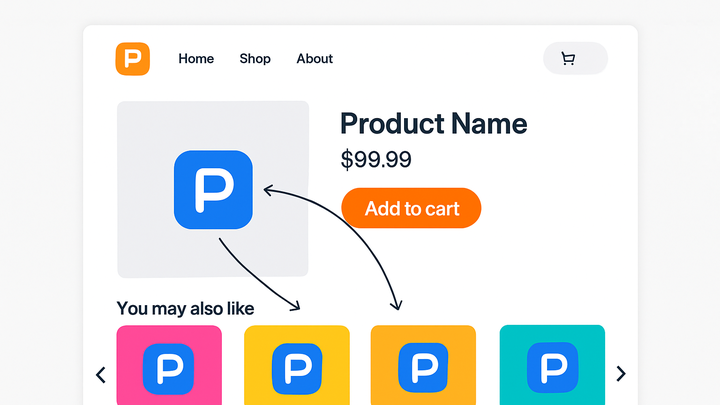Published on 2025-06-29T20:46:05Z
What is Cross-Sell? Examples for Cross-Sell
Cross-selling is the practice of offering customers additional products or services that complement or enhance their current selection, commonly used in e-commerce and SaaS. In the context of CRO, cross-selling can boost average order value (AOV) and revenue by strategically placing relevant suggestions at key touchpoints. From a UX perspective, well-crafted cross-sell prompts help users discover helpful add-ons without feeling intrusive. SEO benefits arise when cross-sell links create a stronger internal linking structure, improving crawl efficiency and site relevance. Tools like prevue.me provide actionable critiques for optimal cross-sell placement, personalization, and performance tracking. By combining data-driven insights with user-centric design, cross-selling transforms passive browsing into meaningful, value-added interactions.
Cross-sell
Offering complementary products or services to existing buyers to boost revenue, enhance UX, and strengthen site SEO.
Why Cross-Selling Matters for CRO, UX, and SEO
Cross-selling elevates revenue and user satisfaction by presenting relevant add-ons during the shopping journey. It directly increases the average order value (AOV) and lifetime customer value. In UX design, cross-sells should feel contextual and helpful, not pushy. From an SEO standpoint, linking to related products reinforces site architecture and supports search engine crawling. Effective cross-selling aligns business goals with genuine user needs.
-
Increased average order value (aov)
By suggesting complementary items, cross-selling encourages customers to add more to their cart, raising the average purchase value over time.
-
Enhanced user experience
Contextual cross-sells help users discover relevant products they might not find on their own, improving satisfaction and engagement.
-
Seo and internal linking
Strategic placement of cross-sell links strengthens internal linking, aiding in page authority distribution and crawlability.
-
Anchor text optimization
Use descriptive anchor text for cross-sell links to signal relevance to search engines.
-
Reduced bounce rate
Relevant suggestions can keep users exploring multiple pages, lowering bounce rate.
-
Common Cross-Selling Techniques
There are multiple tactics to integrate cross-sells smoothly into the user journey. The right technique depends on your product catalog, user intent, and site layout. Below are some widely adopted methods.
-
Product recommendations
Real-time suggestions based on the current product or user behavior, often displayed as carousels or grids.
-
On product pages
Show related items directly below or beside the main product details.
-
In the shopping cart
Offer add-ons before checkout to catch users at decision time.
-
-
Bundle offers
Group complementary products into a discounted package to incentivize multi-item purchases.
-
Fixed bundles
Predefined sets like 'Camera + Memory Card + Case'.
-
Dynamic bundles
Allow customers to build their own bundle for a custom discount.
-
-
Email cross-sells
Post-purchase or abandoned cart emails featuring additional recommended products.
-
Thank you emails
Suggest add-ons after an order confirmation.
-
Abandonment recoveries
Highlight complementary products to rekindle interest.
-
-
On-site pop-ups
Time or behavior-triggered modals that propose relevant add-ons at key moments.
-
Exit-intent offers
Capture users before they leave by suggesting related items.
-
Scroll-triggered banners
Reveal cross-sells after users scroll a certain depth.
-
Implementing Cross-Sells with prevue.me
prevue.me helps you uncover and optimize cross-sell opportunities with actionable critiques, ensuring maximum lead generation and revenue impact.
-
Actionable site audits
prevue.me analyzes your site to pinpoint ideal cross-sell locations and suggests layout improvements.
-
User journey analysis
Leverage heatmaps and session recordings to understand where users are most receptive to cross-sell offers.
-
Heatmap insights
Identify high-engagement areas for placing cross-sell prompts.
-
Session playback
Watch how users navigate and where drop-offs occur.
-
-
A/b testing guidance
Test different cross-sell messages, positions, and formats to determine what drives the best conversion lift.
-
Variant testing
Compare two or more cross-sell layouts with split traffic.
-
Performance metrics
Measure click-through rates, add-to-cart rates, and revenue per session.
-
Best Practices and Common Pitfalls
To maximize cross-sell effectiveness, follow UX-friendly guidelines and avoid tactics that frustrate users.
-
Prioritize relevance
Only suggest items that truly complement the user's selection.
-
Use behavioral data
Leverage browsing and purchase history for personalization.
-
Segment your audience
Tailor cross-sells to different user segments based on interests.
-
-
Maintain a light touch
Avoid overwhelming users with too many offers or intrusive pop-ups.
-
Continuously test and iterate
Regularly review performance data and refine your cross-sell strategy.
-
Monitor impact on ux
Ensure cross-sell implementations do not slow down your site or complicate the checkout process.
-
Performance tracking
Track page load times after adding widgets.
-
User feedback
Gather qualitative insights via surveys or session recordings.
-
